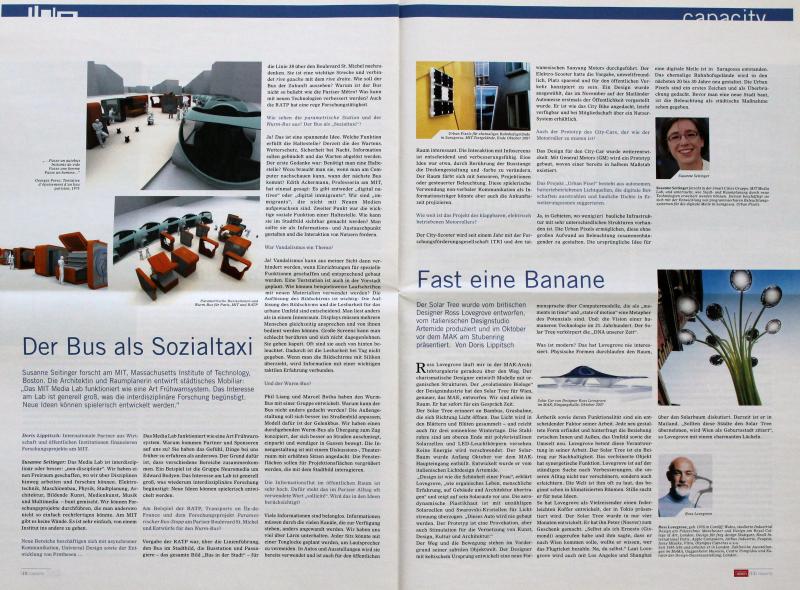
The following bibliography is just the beginning of a collection on more reflective work on design and its relationship to human-computer interaction. Many of these references were also part of my general exams presented on March 13, 2008: http://www.mit.edu/~susannes/generals/index_full.html
Design Thinking
- Beamish, A. Learning from Work: Designing Organizations for Learning and Communication. Stanford, CA: Stanford Business Books. 2008, pp.7-12.
- Boland, R., Collopy, F. Managing as Designing. Stanford, CA : Stanford Business Books, 2004.
- Design Inquiry: MIT Course in Design and Computation, taught for many
years by Bill Porter,
http://ocw.mit.edu/courses/architecture/4-580-inquiry-into-computation-a... - Habraken, N. J., M. Gross, et al. Concept Design Games. Book One:
Developing. Cambridge, MA: Massachusetts Institute of Technology, 1987. - Habraken, N. J., M. Gross, et al. Concept Design Games. Book Two:
Playing. Cambridge, MA: Massachusetts Institute of Technology, 1987. - Kolko, J. The Magic of Design. Oxford University Press, forthcoming. http://www.methodsofsynthesis.com/
- Laurel, B. ed. Design Research: Methods and Perspectives. Cambridge, Mass.: MIT Press, c2003.
- Lawson, B. How designers think: The design process demystified. Oxford ; Burlington, MA: Elsevier/Architectural, 2006.
- Norman, D. A. The Design of Everyday Things. New York: Doubleday, 1990, c1988.
- Pallasmaa, J. The Eyes of the Skin: Architecture and the Senses.
Chichester : Wiley-Academy ; Hoboken, NJ : John Wiley & Sons, 2005. - Rowe, P. G. Design Thinking. Cambridge, MA: MIT Press, c1987. Chapters 1-2.
- Schön, D. The Reflective Practitioner: How Professionals Think in Action. Aldershot [England]: Arena, c1991.
- Simon, H. The Sciences of the Artificial. Cambridge, Mass.: MIT Press, c1996.
Human-Computer Interaction and Design
critical technical practice:
- Agre, P. Critical Technical Practice in in Geof Bowker, Les Gasser,
Leigh Star, and Bill Turner, eds., Bridging the Great Divide: Social
Science, Technical Systems, and Cooperative Work, Erlbaum, 1997.
http://polaris.gseis.ucla.edu/pagre/critical.html - Sengers. P. http://www.cs.cornell.edu/people/sengers
- DiSalvo, C. http://carldisalvo.com/ , http://www.mitpressjournals.org/doi/pdfplus/10.1162/desi.2009.25.1.48
- Dunne, A., & Raby, F. (2001). Design noir: The secret life of
electronic objects. London: August; Basel, Boston, Berlin: Birkhäuser.
cultural probes:
- Gaver, B., Dunne, T., & Pacenti, E. (1999). Design: Cultural
probes. interactions, 6(1), 21-29. DOI=
http://doi.acm.org/10.1145/291224.291235 - Sengers, P. and Gaver, B. 2006. Staying open to interpretation:
engaging multiple meanings in design and evaluation. In Proceedings of
the 6th Conference on Designing interactive Systems (University Park,
PA, USA, June 26 - 28, 2006). DIS '06. ACM, New York, NY, 99-108. DOI=
http://doi.acm.org/10.1145/1142405.1142422
design research:
- Zimmerman, J., Forlizzi, J., & Evenson, S. (2007). Research
through design as a method for interaction design research in HCI. In
Proc. of SIGCHI Conference on Human Factors in Computing Systems,
CHI’07, ACM, New York, NY, 493-502. DOI=
http://doi.acm.org/10.1145/1240624.1240704 - Wolf, T. V., Rode, J. A., Sussman, J., & Kellogg, W. A. (2006).
Dispelling “design” as the black art of CHI. In Proc. of the SIGCHI
Conference on Human Factors in Computing Systems, CHI ‘06, ACM, New
York, NY, 521-530. DOI= http://doi.acm.org/10.1145/1124772.1124853 - Boehner, K., Sengers, P., & Warner, S. (2008). Interfaces with the
ineffable: Meeting aesthetic experience on its own terms. ACM Trans.
Comput.-Hum. Interact, 15(3), 1-29. DOI=
http://doi.acm.org/10.1145/1453152.1453155
social vs. technical:
- Ackerman, M. (2000). The intellectual challenge of CSCW: The gap
between social requirements and technical feasibility. Human Computer
Interaction. 15, 179-203.
http://www.eecs.umich.edu/~ackerm/pub/00a10/hci.final.pdf
iterative design:
- Verplank, W. Design Sketchbook. December 2009. http://www.billverplank.com/IxDSketchBook.pdf